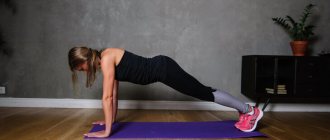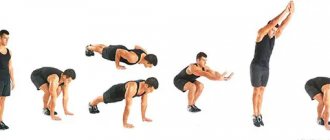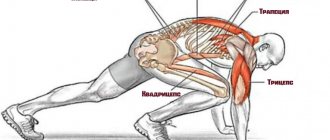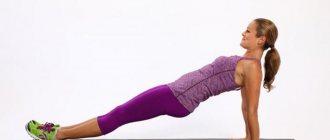Vacuum – one of the most effective exercises for strengthening the abdominal muscles. It arose from the ancient practices of yoga, and gained its popularity during the “golden era of bodybuilding.”
The calling card of athletes of that time was the so-called V-shaped figure: developed shoulders, a wide chest and, of course, a flat, sculpted stomach and a narrow waist. Bodybuilding legend Arnold Schwarzenegger admitted that such an aesthetic combination is achieved largely through the “abdominal vacuum” exercise.
To understand why to do a vacuum, how to do it and how the effect of its implementation occurs, let us turn in the article to the structure of the abdominal muscles.
Anatomy of the abdominal muscles
The abdominal press consists of external and internal muscle groups:
- External abdominal muscles: Rectus.
- External oblique.
- Internal oblique.
The deepest layer is formed by the transverse abdominal muscles, which encircle the waist and act as a natural corset.
That is, it is this muscle group that is responsible for supporting the internal organs and a flat stomach. The absence of loads on the transverse muscle group contributes to:
- The appearance of excess weight at the waist, since the fibers of these muscles are of the slow type, using subcutaneous fat as an energy source.
- Lack of strength in the muscle corset, which leads to the internal organs squeezing the abdomen forward.
Classic exercises for training the abs (lifting the body, legs, twisting, etc.) mainly work only the external muscle groups that form the relief.
To effectively strengthen the transverse muscles, it is necessary to do static (isometric) exercises. Along with the plank, the best example of a static exercise for developing the internal abdominal muscles is the vacuum .
How is it useful?
Systematic implementation of abdominal vacuum allows:
- get rid of a stretched and bulging belly;
- significantly reduce your waist size;
- strengthen the abdominal muscles;
- visually enlarge the chest;
- improve posture;
- stabilize the spine and reduce pain in the lower back;
- improve digestion and blood supply to the abdominal organs;
- strengthen the diaphragm muscles;
- reduce the visceral layer of fat that accumulates near the internal organs.
In addition, vacuum gymnastics classes do not require special equipment and are suitable for performing at home and in the office.
Benefits of the abdominal vacuum exercise:
- makes a flat stomach and a thin waist;
- reduces the volume of visceral fat - the cause of diabetes, cardiovascular diseases and obesity;
- improves blood supply to the abdominal organs, thereby improving their condition and function;
- normalizes the digestion process;
- has an auxiliary therapeutic effect in cases of prolapse of internal organs;
- improves the functional state of the lumbar spine and posture, reduces lower back pain;
- has a relaxing effect on the nervous system;
helps restore shape after childbirth and cesarean section (in these cases it can be done with the permission of the doctor).
How is it done?
In order to do a stomach vacuum correctly, you need to understand its technique. Although at first glance it seems simple, this technique consists of many nuances, mainly related to the intricacies of proper breathing, and includes the following steps.
Namely:
- Position yourself in the starting position.
- Take a deep breath through your nose, trying to direct the air not so much into your lungs as down your stomach. The press should move forward.
- Exhale sharply through your mouth, trying to release all the air out. To do this, you can use the sound “Pha!”
- Hold your breath.
- As you exhale, pull your stomach in as much as possible towards the spine and up, under the ribs.
- Stay in the position as much as possible. To begin with, the duration of the isometric contraction can be 10-15 seconds.
- Gradually relaxing your abs, inhale slowly.
- In the starting position, inhale and exhale 2-3 times, then repeat the exercise the required number of times.
It is necessary to make a vacuum on an empty stomach or 3-4 hours after eating.
Depending on the initial position, the abdominal vacuum is divided into four types:
- lying down;
- on the knees;
- sitting;
- standing.
The technical component of the exercise in each position remains unchanged. The only difference is the complexity of its implementation.
Vacuum lying down
The supine vacuum is considered one of the easiest to perform and is suitable for any beginner. In this position, gravity itself helps to retract the abdominal muscles.
How to do:
- Sit on a flat surface.
- Straighten your arms along your body.
- Bend your knees or stretch your legs forward.
- Apply the vacuum using proper technique.
Vacuum on your knees
As soon as you have mastered the technique of the “vacuum” exercise and can easily do 3-5 approaches of 1-2 minutes in a lying position, you can begin to vacuum on your knees (“on all fours”).
This option is considered somewhat complicated, because in this case you need to create a vacuum against gravity.
How to do:
- Sit on your knees.
- Place your palms on the floor at shoulder level.
- Do not bend your elbows and make sure your back is straight: do not slouch or arch your lower back.
- Apply the vacuum using proper technique.
Vacuum sitting
Sitting vacuum is another complicated option that uses the stabilizer muscles responsible for maintaining the balanced position of the spine.
How to do:
- Sit on a chair or any flat surface.
- Place your hands on your knees.
- Do not lean against the back of the chair.
- Control the position of your back: it should remain straight.
- Apply the vacuum using proper technique.
If desired, you can complicate the task and increase the load in this position. To do this, you need to sit not on a chair, but on a surface that provides unstable support, for example, a fitball.
You can also do a vacuum in the abdomen while sitting on your knees (not to be confused with a vacuum “on all fours”, where the body is parallel to the floor):
- Get on your knees.
- Take a sitting position.
- Move your hips away from your heels by 20-25 cm.
- Make sure that the body is perpendicular to the floor.
- Apply the vacuum using proper technique.
Vacuum standing
As you progress, move on to the most difficult type - standing vacuum. This option will allow you to maximize the use of the internal abdominal muscles and back stabilizer muscles.
How to do:
- Stand straight with your feet shoulder-width apart and knees slightly bent.
- Straighten your arms along your body.
- Make sure your back remains straight and your shoulders down.
- Apply the vacuum using proper technique.
There are several more variations of performing a vacuum from a standing position:
- Simplified standing vacuum. The hands are placed on the knees, the body moves forward, resulting in additional support.
- Complicated standing vacuum. The hands are placed behind the head, which allows the upper abdominal muscles to be even more involved in the work.
Execution options
The easiest way to perform the exercise is to lie on your back, legs bent at the knees, feet shoulder-width apart, lower back pressed to the floor. In this case, the force of gravity acts on the internal organs. It is this version of the “vacuum” that is recommended for beginner athletes.
As athletic progress is achieved, the “abdominal vacuum” is performed while sitting, then standing. The most difficult version of the exercise is standing on all fours.
Sitting engages the muscles that support the spine. Legs should be bent at the knees at an angle of 90°, feet resting on the floor, palms on the knees. When performing the exercise while standing, the legs are shoulder-width apart, the arms are lowered along the body or on the belt. After you have mastered the basic exercise while standing, you can move on to a more complicated version - leaning forward, hands resting on your knees or a sports equipment at waist level.
In the position of standing on all fours, when retracting the abdomen, you also have to overcome the force of gravity, so this version of the exercise is recommended for advanced athletes. The shoulders should be strictly above the arms, the hips should be above the knees, and the neck should be parallel to the floor. It is important to keep your back straight - not to bend.
Efficiency
- The effectiveness of a vacuum for the abdomen directly depends on the regularity and intensity of training. Obviously, after a few sessions, your stomach will not become flat and your waist will not become thin.
- It is very important to do the vacuum daily or at least 5 times a week, and also to constantly improve and complicate this exercise.
- If initially you can hold your breath and contract the abdominal position for 10-15 seconds, then gradually try to increase this time by 1-2 seconds.
- When one isometric contraction when performing a vacuum from a lying position is 40-50 seconds, you can do a vacuum on your knees, then do a vacuum from a sitting position, and, in the end, the most difficult option - a standing vacuum. But this is not the limit, because you can master the “nauli” technique - vacuum using wave-like movements of the abdominal muscles.
The result of performing a vacuum will appear even earlier if you control the internal transverse muscles throughout the day. To do this, you don’t need to hold your breath or suck in your stomach, you just need to always keep your abs tense. After some time, this will become a habit and the key to a flat stomach and a wasp waist.
How does a vacuum work?
The vacuum creates low pressure in the development area. This “stirs up” the fluid environment of our body: blood, lymph, interstitial fluid. All fluid matter tends from the area where the pressure is increased to the area where it is reduced - these are their physical properties.
Where vacuum cans work:
- blood flows faster, vascular tension is relieved, dormant capillaries “wake up” - trophism (nutrition) of cells improves, metabolism accelerates,
- interstitial fluid is more actively “pumped out” from the intercellular matrix and, in the form of lymph, goes for cleaning and removal from the body - this removes congestion, accelerates the elimination of toxins and waste, strengthens the body’s protective functions,
- subcutaneous and visceral fat is burned,
- The production of elastin and collagen fibers is activated, sticky tissues are loosened - this stimulates regeneration and restoration of the affected areas.
Cupping doesn't just suck in the skin. The effect also occurs at the myofascial level: spasms are relieved, healthy tone and elasticity of muscles and fascia are restored.
Useful tips
The best tips for performing a vacuum and subsequently losing weight:
- Perform the vacuum on an empty stomach . It is best if this becomes a daily habit: do a vacuum in the morning before breakfast or in the evening shortly before bed.
- In order to master the correct technique , initially do the vacuum in its simplest variation - from a lying position.
- Pay attention to proper breathing : you need to learn to “breathe with your stomach.”
- Use the sound "Pha!" in order to completely release the air out when exhaling;
- When making a vacuum, try to “glue” the navel to the spine and at the same time pull the internal organs under the ribs;
- Hold the vacuum as long as possible , listening to your feelings.
- Each workout, try to increase the time of isometric contraction by 1-2 seconds.
- Relax the retracted abdomen slowly and gradually , then the transverse muscle will work throughout the entire exercise.
- Do 2-3 sets of the abdominal vacuum exercise, 10-15 repetitions.
- Rest between sets for 1-2 minutes.
Vacuum press training program
Any exercise loses its effectiveness if you do not try to mentally focus as much as possible on the work of the necessary muscle groups and do not adhere to the principle of progression of loads, and the vacuum for the press is no exception.
When you are just starting to master this exercise, I recommend starting with three approaches, within each of which you will perform 7-8 delays for 15-20 seconds. Rest between sets is about one minute.
Perform the vacuum in this mode every other day, after a week it will be quite easy for you, then increase the “retraction” time to 30-35 seconds. Then up to 50 seconds, up to a minute and so on.
The duration of abdominal vacuum training should not exceed 25-30 minutes , then an unfavorable load will begin on the nerve endings of the gastrointestinal tract, which is fraught with unpleasant sensations (bloating, heartburn, etc.), and the effectiveness of the exercise will decrease. Try to spend this time with maximum intensity: with full mental concentration on the work of the transverse abdominal muscle, statically maintaining the correct position, even breathing and minimal rest between sets.
The easiest way to perform a vacuum is on an empty stomach, so I recommend doing it in the morning or before bed, the productivity of your workout will only increase from this, you will quickly start the process of breaking down visceral fat and empty glycogen depots. You can combine the vacuum with your standard abdominal workout, in which you perform dynamic exercises, or with cardio exercise.
Crossfit complex
For those who like really hard training, I recommend the following combination of exercises:
- plank (at least one minute);
- lying crunches (at least 15 repetitions);
- vacuum standing on all fours (5-6 repetitions with the longest possible delay);
- hanging leg raises (at least 10 repetitions).
Exercises are performed one after another, with minimal rest. Three or four approaches will be more than enough for a full workout.
The complexity of such a complex is due to the fact that within it we alternate static and dynamic exercises, thereby working the maximum number of abdominal muscle fibers in a short period of time.
It is believed that any dynamic abdominal exercises increase the volume of the rectus abdominis muscle and visually increase the volume of the abdomen itself. Of course, this is not entirely correct. Now we will not go into these features, but by training the abs in a similar style, we protect ourselves from such an undesirable effect, since we perform a vacuum at the moment when the abdominal muscles are maximally clogged with blood. Of course, making a vacuum after such exercises is much more difficult, but you must remember that beautiful, sculpted abs are always difficult, so few people can boast of truly developed and beautiful abdominal muscles. Moreover, this effort on oneself occurs not only in the gym, but also in the kitchen.
Is vacuum gymnastics safe for the abdomen?
Abdominal vacuum is an exercise that does not require professional coordination, specialized equipment or knowledge. If the correct technique is followed, as well as the absence of contraindications, discomfort and unpleasant sensations, vacuum gymnastics cannot harm the body and is safe.
In yoga, it is generally believed that vacuum helps rejuvenate the internal glands, nerves of the gastric tract and intestines, removes toxins, improves blood supply to internal organs and strengthens the back muscles.
Is it possible to do a vacuum during menstruation?
Despite its safety, benefits and effectiveness, vacuum has its limitations. In women, tension in the internal abdominal muscles as a result of performing it causes contractions of the uterus.
Therefore, it is strictly forbidden to make a vacuum:
- During menstruation (menstruation, because the vacuum will increase bleeding).
- During pregnancy (since a vacuum can provoke some undesirable consequences, including miscarriage).
- Immediately after childbirth (how long after childbirth will be determined only by a gynecologist).
Contraindications
There are several other contraindications for which vacuum gymnastics should be abandoned:
- Stomach ulcer.
- Duodenal ulcer.
- Other diseases of the abdominal cavity.
- Recovery period after surgery.
- Diseases of the respiratory system.
- Diseases of the cardiovascular system.
- The period of exacerbation of chronic diseases.
- Infection.
- Dizziness, abdominal pain, as well as other unpleasant sensations that occur during the vacuum.
It should be understood that the absence of the above circumstances is not a guide to action. And before you start regularly doing a vacuum, you need to consult a doctor.
Vacuum is an extremely effective and easy-to-perform local exercise for the abdominal muscles. But, of course, it does not get rid of subcutaneous fat on the stomach and body.
In order for your waist to really become aspen and beautiful, you need a whole range of measures: regularly engage in cardio training (aerobic exercise) and adhere to proper nutrition.
What errors occur when performing the exercise?
Listed below are the main mistakes that occur among athletes who are mastering a abdominal vacuum. These technical errors do not pose a serious risk of injury, but can significantly delay your progress:
- Do not round your back at the thoracic spine while performing a vacuum, you will not be able to concentrate on correct fixation of the abdominal area.
- You should not do a vacuum immediately after a heavy meal ; the best time for this exercise is in the morning, on an empty stomach. At this time of day, catabolic processes predominate in the body, and this way you will increase the lipolysis of visceral fat.
- Regular physical activity is great, but you shouldn’t go crazy on this issue. Do not perform this exercise if you feel pain or discomfort in the stomach or intestines, or if you experience soreness in the abdominal muscles. Girls are not recommended to do a vacuum during menstruation or during pregnancy; excessive physical stress on the abdominal muscles can make adjustments to the menstrual cycle and the functioning of the reproductive system.
- Watch your breathing , it should not be harsh. You need to breathe deeply, but smoothly and measuredly.









